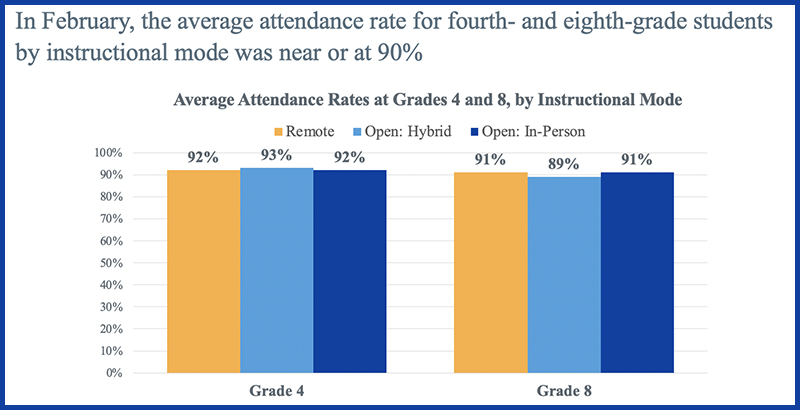More Black Students Return to School, But Attendance Rates Hover Below 90 Percent

The percentage of Black students returning to in-person learning has inched up since January, according to the latest update on pandemic school participation from the Institute of Education Sciences.
At fourth grade, the monthly School Survey shows the percentage of Black students in remote-only classrooms dropped from 58 to 54 percent. While white students are still attending school in person or in hybrid plans at higher rates than Black, Hispanic and Asian students, that’s starting to change.
“We are beginning to see shifts toward full-time, in-person learning for other groups,” Peggy Carr, associate commissioner of the assessment division at the National Center for Education Statistics, said in a statement. In addition, the data shows the percentage of fourth graders with disabilities in remote-only classrooms dropped from 38 to 35 percent.
The tracker complies with the executive order President Joe Biden issued on his first full day in office. Based on a sample of 3,500 schools each at fourth and eighth grade — but representative of elementary and middle schools in general — the site includes two new elements that provide further context as the push to reopen schools continues. Average rates of attendance are included as well as teacher vaccination rates. The data on vaccinations, however, lags behind more current numbers released by the Centers for Disease Control and Prevention on Tuesday, showing that almost 80 percent of teachers, other school employees and child care providers have now received at least one shot.
In addition on Tuesday, Biden moved up the date for anyone 16 and older to be eligible for the vaccine from May 1 to April 19.
“We’re in a situation where I believe by end of the summer, we’ll have a significant portion of the American public vaccinated,” he said while visiting a vaccination site in Virginia.
The wide availability of vaccines — as well as further updated guidance from the Centers for Disease Control and Prevention saying that frequent and deep cleaning is no longer necessary — should allow more districts to offer in-person classes five days a week.
On attendance, schools are seeing similar rates, regardless of whether students are learning in person, remotely or in a hybrid plan — about 90 percent on average, according to the IES data.
But rates for Black students are below that, especially for eighth graders, regardless of how they are attending school. Fourth grade attendance rates ranged from a high of 95 percent for Asian students in distance learning to less than 80 percent for American Indian, Hawaiian and other native student groups.
The national data, however, is likely covering up widening gaps at the local level between students with satisfactory attendance and those with “severe chronic absence,” meaning they’ve missed at least 10 percent of the school year so far, said Hedy Chang, executive director of Attendance Works, a national nonprofit organization.
She called average daily attendance a “bad, unhelpful metric” and said even chronic absenteeism rates are not a good measure of missed instructional time.
The national picture of attendance builds on what some states are already collecting on a monthly basis.
- In Connecticut, attendance rates are comparable to the 2019-20 school year before the pandemic, except for students with high needs, according to a March report from the state education department. Among English learners, low-income students and those with disabilities, rates are “substantially lower” than before the pandemic, especially among low-income students who also have at least one other need, such as a disability.

- In Ohio, districts participating in a student engagement initiative have seen an increase in students who are chronically absent.
- In Rhode Island, the percentage of students with “excessive” absences, meaning they’ve missed between 20 percent and 50 percent of the school year, has increased from 4 percent in March 2020, before the pandemic, to 11 percent as of Feb. 11.
Chang attributes the increases in absenteeism, in part, to the digital divide.
“If you have internet connectivity, it is easier to show up in distance learning and be counted as showing up,” she said. “But if you don’t have decent internet access and you’re highly mobile, then you end up in real trouble.”
She added that because “showing up is easier” in remote learning, the data on chronic absenteeism is likely underestimating how much instructional time students are missing.
Since the beginning of the pandemic, she said, schools have emphasized daily check-ins with students to monitor their well-being. As a result, she said, “attendance became less meaningful as a measure of exposure to instruction.”
Get stories like these delivered straight to your inbox. Sign up for The 74 Newsletter

;)
